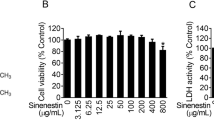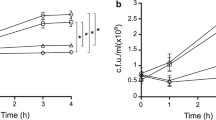Abstract
Respiratory syncytial virus (RSV) is the most common pathogen responsible for lower respiratory diseases in children. So far, there is no effective treatment or preventative vaccine available for RSV infection, although ribavirin and dexamethasone are commonly prescribed. Resveratrol has been shown to inhibit the replication of several other viruses, thus the effect of resveratrol on RSV-induced inflammatory mediators in 9HTEo cell cultures was evaluated, and possible mechanisms of action were explored and compared with dexamethasone and ribavirin. Incubation with resveratrol resulted in decreased IL-6 production and partial inhibition of RSV replication. Resveratrol treatment also inhibited virus-induced TIR-domain-containing adapter-inducing interferon-β (TRIF) and TANK binding kinase 1 (TBK1) protein expression. These data demonstrate the ability of resveratrol to inhibit cytokine production by RSV in airway epithelial cells, indicating that it might be a therapeutic agent with both anti-inflammatory and antiviral potential for the treatment of RSV infection.






Similar content being viewed by others
REFERENCES
Jiang, Z., M. Kunimoto, and J.A. Patel. 1998. Autocrine regulation and experimental modulation of interleukin-6 expression by human pulmonary epithelial cells infected with respiratory syncytial virus. Journal of Virology 72(3): 2496–2499.
Mastronarde, J.G., M.M. Monick, T.J. Gross, and G.W. Hunninghake. 1996. Amiloride inhibits cytokine production in epithelium infected with respiratory syncytial virus. American Journal of Physiology (2 Pt 1):L201–L207.
Roosevelt, G., K. Sheehan, J. Grupp-Phelan, R.R. Tanz, and R. Listernick. 1996. Dexamethasone in bronchiolitis: a randomised controlled trial. Lancet 348(9023): 292–295.
Buckingham, S.C., H.S. Jafri, and A.J. Bush. 2002. A randomized, double-blind, placebo-controlled trial of dexamethasone in severe respiratory syncytial virus (RSV) infection: effects on RSV quantity and clinical outcome. Journal of Infectious Diseases 185(9): 1222–1228.
van Woensel, J.B., W.M. van Aalderen, W. de Weerd, N.J. Jansen, J.P. van Gestel, D.G. Markhorst, et al. 2003. Dexamethasone for treatment of patients mechanically ventilated for lower respiratory tract infection caused by respiratory syncytial virus. Thorax 58(5): 383–387.
Guerguerian, A.M., M. Gauthier, M.H. Lebel, C.A. Farrell, and J. Lacroix. 1999. Ribavirin in ventilated respiratory syncytial virus bronchiolitis. A randomized, placebo-controlled trial. American Journal of Respiratory and Critical Care Medice 160(3): 829–834.
Docherty, J.J., M.M. Fu, B.S. Stiffler, R.J. Limperos, C.M. Pokabla, and A.L. DeLucia. 1999. Resveratrol inhibition of herpes simplex virus replication. Antiviral Research 43(3): 145–155.
Palamara, A.T., L. Nencioni, K. Aquilano, G. De Chiara, L. Hernandez, F. Cozzolino, et al. 2005. Inhibition of influenza A virus replication by resveratrol. Journal of Infectious Diseases 191(10): 1719–1729.
Evers, D.L., X. Wang, S.M. Huong, D.Y. Huang, and E.S. Huang. 2004. 3,4′,5-Trihydroxy-trans-stilbene (resveratrol) inhibits human cytomegalovirus replication and virus-induced cellular signaling. Antiviral Research 63(2): 85–95.
Docherty, J.J., T.J. Sweet, E. Bailey, S.A. Faith, and T. Booth. 2006. Resveratrol inhibition of varicella-zoster virus replication in vitro. Antiviral Research 72(3): 171–177.
Youn, H.S., J.Y. Lee, K.A. Fitzgerald, H.A. Young, S. Akira, and D.H. Hwang. 2005. Specific inhibition of MyD88-independent signaling pathways of TLR3 and TLR4 by resveratrol: molecular targets are TBK1 and RIP1 in TRIF complex. Journal of Immunology 175(5): 3339–3346.
Groskreutz, D.J., M.M. Monick, L.S. Powers, T.O. Yarovinsky, D.C. Look, and G.W. Hunninghake. 2006. Respiratory syncytial virus inducesTLR3 protein and protein kinase R, leading to increased double-stranded RNA responsiveness in airway epithelial cells. Journal of Immunology 176(3): 1733–1740.
Rudd, B.D., J.J. Smit, R.A. Flavell, L. Alexopoulou, M.A. Schaller, A. Gruber, et al. 2006. Deletion of TLR3 alters the pulmonary immune environment and mucus production during respiratory syncytial virus infection. Journal of Immunology 176(3): 1937–1942.
Majde, J.A. 2000. Viral double-stranded RNA, cytokines, and the flu. Journal of Interferon and Cytokine Research 20(3): 259–272.
Xie, X.H., H.K. Law, L.J. Wang, X. Li, X.Q. Yang, and E.M. Liu. 2009. Lipopolysaccharide induces IL-6 production in respiratory syncytial virus-infected airway epithelial cells through the toll-like receptor 4 signaling pathway. Pediatric Research 65(2): 156–162.
Donnelly, L.E., R. Newton, G.E. Kennedy, P.S. Fenwick, R.H. Leung, K. Ito, et al. 2004. Anti-inflammatory effects of resveratrol in lung epithelial cells: molecular mechanisms. American Journal of Physiology. Lung Cellular and Molecular Physiology 287(4): 774–783.
Ciencewicki, J., L. Brighton, W.D. Wu, M. Madden, and I. Jaspers. 2006. Diesel exhaust enhances virus- and poly(I:C)-induced Toll-like receptor 3 expression and signaling in respiratory epithelial cells. American Journal of Physiology. Lung Cellular and Molecular Physiology 290(6): L1154–L1163.
Melkamu, T., D. Squillace, H. Kita, and S.M. O'Grady. 2009. Regulation of TLR2 expression and function in human airway epithelial cells. Journal of Membrane Biology 229(2): 101–113.
Guillot, L., R. Le Goffic, S. Bloch, N. Escriou, S. Akira, M. Chignard, et al. 2005. Involvement of toll-like receptor 3 in the immune response of lung epithelial cells to double-stranded RNA and influenza A virus. Journal of Biological Chemistry 280(7): 5571–5580.
Le Goffic, R., V. Balloy, M. Lagranderie, L. Alexopoulou, N. Escriou, R. Flavell, et al. 2006. Detrimental contribution of the Toll-like receptor (TLR)3 to influenza A virus-induced acute pneumonia. PLoS Pathogens 2(6): e53.
Libermann, T.A., and D. Baltimore. 1990. Activation of interleukin-6 gene expression through the NF-kappa B transcription factor. Molecular and Cellular Biology 10(5): 2327–2334.
Li, Z.W., R.C. Rickert, and M. Karin. 2004. Genetic dissection of antigen receptor induced-NF-kappaB activation. Molecular Immunology 41(6–7): 701–714.
Yamamoto, M., S. Sato, H. Hemmi, K. Hoshino, T. Kaisho, H. Sanjo, et al. 2003. Role of adaptor TRIF in the MyD88-independent toll-like receptor signaling pathway. Science 301(5633): 640–643.
Cusson-Hermance, N., S. Khurana, T.H. Lee, K.A. Fitzgerald, and M.A. Kelliher. 2005. Rip1 mediates the Trif-dependent toll-like receptor 3- and 4-induced NF-{kappa}B activation but does not contribute to interferon regulatory factor 3 activation. Journal of Biological Chemistry 280(44): 36560–36566.
Tojima, Y., A. Fujimoto, M. Delhase, et al. 2000. NAK is an IkappaB kinase-activating kinase. Nature 404(6779): 778–782.
An, H., W. Zhao, J. Hou, Y. Zhang, Y. Xie, Y. Zheng, et al. 2006. SHP-2 phosphatase negatively regulates the TRIF adaptor protein-dependent type I interferon and proinflammatory cytokine production. Immunity 25(6): 919–928.
Levine, S.J., P. Larivée, C. Logun, C.W. Angus, and J.H. Shelhamer. 1993. Corticosteroids differentially regulate secretion of IL-6, IL-8, and G-CSF by a human bronchial epithelial cell line. American Journal of Physiology 265(4 Pt1): L360–L368.
De Franceschi, L., G. Fattovich, F. Turrini, K. Ayi, C. Brugnara, F. Manzato, et al. 2000. Hemolytic anemia induced by ribavirin therapy in patients with chronic hepatitis C virus infection: role of membrane oxidative damage. Hepatology 31(4): 997–1004.
Zang, N., X. Xie, Y. Deng, S. Wu, L. Wang, C. Peng, et al. 2011. Resveratrol-mediated gamma interferon reduction prevents airway inflammation and airway hyperresponsiveness in respiratory syncytial virus-infected immunocompromised mice. Journal of Virology 85(24): 13061–13068.
Leonard, S.S., C. Xia, B.H. Jiang, B. Stinefelt, H. Klandorf, and G.K. Harris. 2003. Resveratrol scavenges reactive oxygen species and effects radical-induced cellular responses. Biochemical and Biophysical Research Communications 309(4): 1017–1026.
Baur, J.A., and D.A. Sinclair. 2006. Therapeutic potential of resveratrol: the in vivo evidence. Nature Reviews. Drug Discovery 5(6): 493–506.
Lu, C., I.F. Bambang, J.S. Armstrong, and M. Whiteman. 2008. Resveratrol blocks high glucose-induced mitochondrial reactive oxygen species production in bovine aortic endothelial cells: role of phase 2 enzyme induction? Diabetes, Obesity & Metabolism 10(4): 347–349.
Liu, T., S. Castro, A.R. Brasier, M. Jamaluddin, R.P. Garofalo, and A. Casola. 2004. Reactive oxygen species mediate virus-induced STAT activation: role of tyrosine phosphatases. Journal of Biological Chemistry 279(4): 2461–2469.
Castro, S.M., A. Guerrero-Plata, G. Suarez-Real, P.A. Adegboyega, G.N. Colasurdo, and A.M. Khan. 2006. Antioxidant treatment ameliorates respiratory syncytial virus-induced disease and lung inflammation. American Journal of Respiratory and Critical Care Medicine 174(12): 1361–1369.
ACKNOWLEDGMENTS
This study was supported by the Program for New Century Excellent Talents in University (06-775), the Key program of Chongqing Medical University, and Specialized Research Fund for the Doctoral Program of Higher Education of China (Grant No. 20105503120003)
Author information
Authors and Affiliations
Corresponding author
Rights and permissions
About this article
Cite this article
Xie, Xh., Zang, N., Li, Sm. et al. Resveratrol Inhibits Respiratory Syncytial Virus-Induced IL-6 Production, Decreases Viral Replication, and Downregulates TRIF Expression in Airway Epithelial Cells. Inflammation 35, 1392–1401 (2012). https://doi.org/10.1007/s10753-012-9452-7
Published:
Issue Date:
DOI: https://doi.org/10.1007/s10753-012-9452-7




